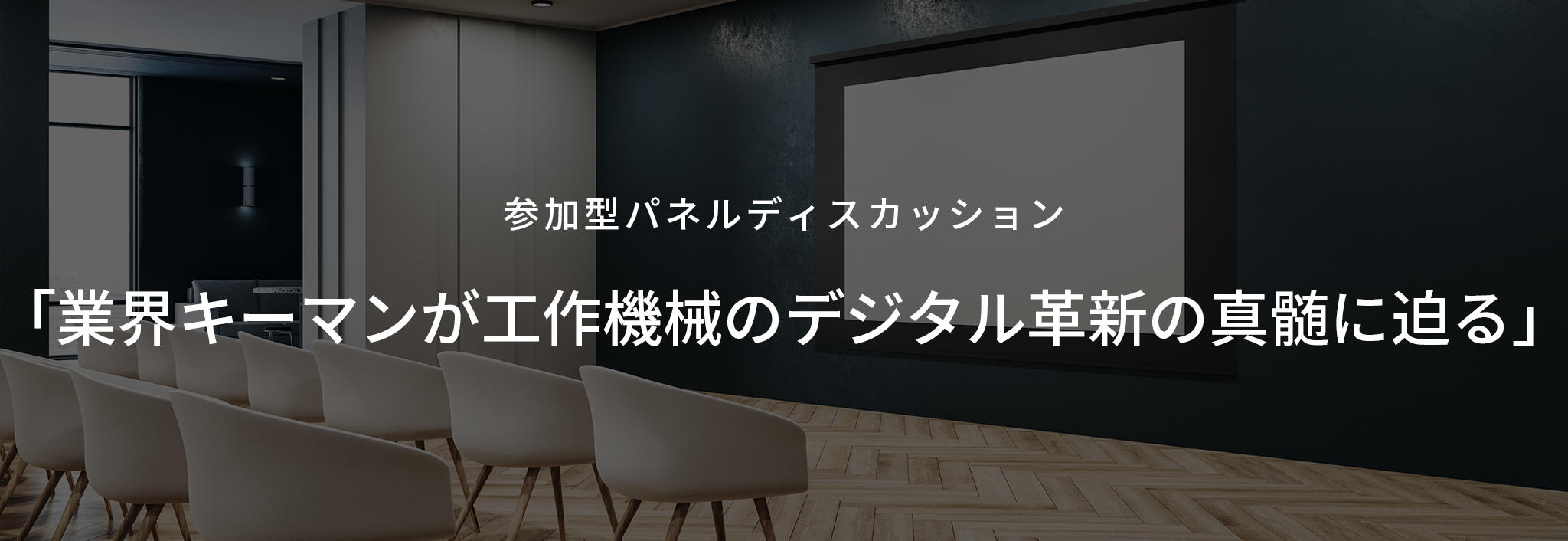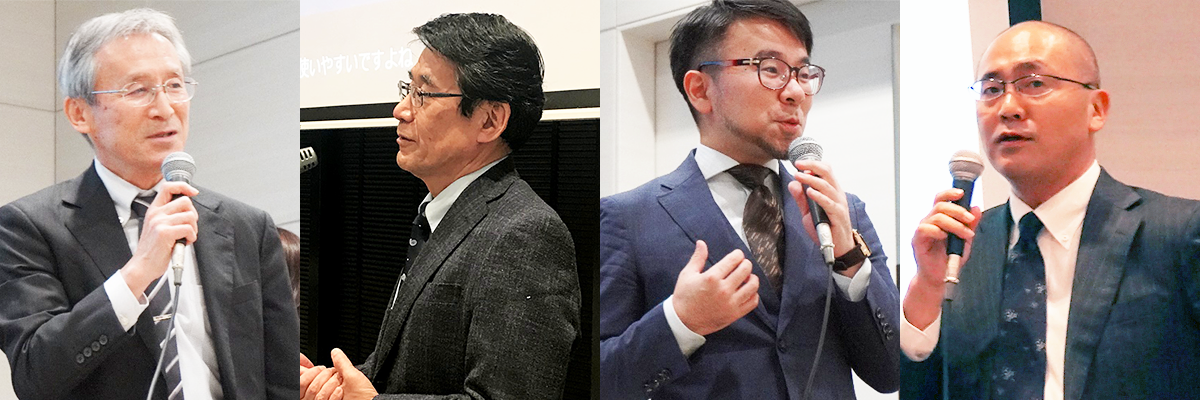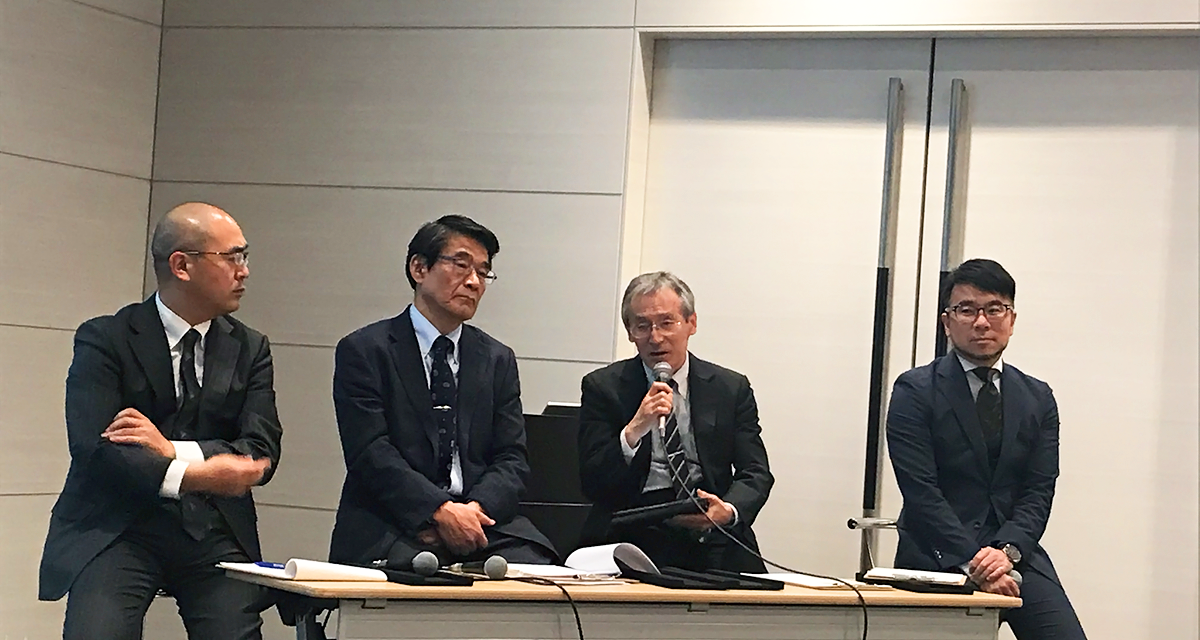
The other day, we invited a machine tool manufacturer with whom we have a relationship and held a technical exchange meeting.
The technical exchange meeting consisted of the following four programs.
The first program, ``EMO Report,'' has an article in our column, so please see it below.
1. EMO Blog ① (3 times in total)
2. Participatory panel discussion] Key industry figures explore the essence of digital innovation in machine tools
3. [Lecture by Macnica Engineer] Key technologies driving digital innovation
4. [Special Lecture] Fighting the world through value change - How we were able to transform from Ise's long-established restaurant "Ebiya" to one of the world's leading AI companies "EBILAB" -
Here we would like to introduce the contents of the second program, a participatory panel discussion titled "Key industry figures approach the essence of digital innovation in machine tools."
Participatory panel discussion "Key persons in the industry approach the essence of digital innovation in machine tools"
We asked four key figures in the industry to talk about the technologies that are essential for the digital transformation of machine tools and the prospects for future business forms from their respective standpoints.

Panelists from left
Hiroyuki Maehara, General Manager, IT Promotion Department, Technology and Quality Headquarters, Toshiba Machine Co., Ltd.
Director of the Japan Institute of Technology Museum of Technology / Professor Emeritus of Sophia University / Representative of MAMTEC Shinji Shimizu
Core Concept Technology Co., Ltd. Board Director and CTO Noriaki Taguchi
Yasuyuki Kaneda, Deputy General Manager, Macnica Innovation Strategic Business Headquarters
Moderator
Macnica Innovation Strategy Business Headquarters Solutions Division Fukuoka Hiroshi
Theme 1: The latest digital technology and its utilization that industry key persons are paying attention to
First of all, in addition to technologies such as AI and IoT, efforts are being made to develop new technologies such as digital twins and 5G.
- Mr. Maehara
From the detection of signs of failure using sensors and the detection of tool wear to the automation of machining procedures, I feel that a wide range of on-site applications are progressing.
In addition, we believe that metal additive manufacturing using next-generation technology can aim for optimization of processing, quality improvement, and stability.
Furthermore, I feel that we can expand into the consumables business such as laser heads.
- Mr. Taguchi
From my standpoint, I often talk with small and medium-sized processing manufacturers, and one of the issues I feel at worksites is the passing on of veteran and craftsmanship techniques.
I hope that AI x IoT will support on-site work, which is particularly difficult to hand over, and automate it to make it easier.
For example, I think that quotations and process design can be mentioned.
- Mr. Shimizu
As the two of you said, it is important to digitize both the machining process and process design, and visualize them using IoT and AI. We believe that visualization is the great significance of digitization.
By accurately visualizing the workplace, the entire manufacturing system can be visualized, and I believe that the use of digital technology will further advance.
I hope that all of the manufacturers gathered today will use this visualization of manufacturing sites to create machine tools that will further enhance the strength of Japan in the field, and win the competition.
- Kaneda
Certainly, even if we say digitalization in one word, I felt that there is a wide range of applications from processing technology to the entire process.
In particular, I think that value provision is moving toward supporting the entire process from a single machine, and the point is how to approach so-called customer success.
- Moderator
By the way, the business model for subscriptions is progressing in the world, but I would like to ask Mr. Maehara about the state of subscriptions for machine tool manufacturers.
- Mr. Maehara
I think there will inevitably be a shift from selling things to selling things in this industry, and there are many manufacturers who are thinking about providing such business models and apps.
As for myself, of course, I would like to be able to provide a reasonably priced service that allows users to use the machine with peace of mind.
- Moderator
Currently, I think that the closest thing is to subscribe from maintenance and maintenance services, which are often supported on a case-by-case basis. What do you think?
- Mr. Maehara
yes. Of course, I'm thinking about that, but the difficult part is that the culture of providing services at a fixed price has not yet permeated the industry, and I don't think there are any machine tool manufacturers that have managed to take root in the subscription business.
After all, we believe that we must firmly create the content of the service so that users can feel the value of paying a fixed amount.
- Moderator
What do you think about the technical elements necessary for subscribing?
- Kaneda
I think the key point in realizing a subscription business for machine tools is how to manage unique data flowing on the network, such as the app billing system.
When 5G arrives in the future, it will become easier to manage application-specific information, so we believe it will be one of the key technologies for subscribing.
As an aside, as a company involved in electronics, we have witnessed the speed with which the rise of smartphones has swept the digital camera market.
At the time, even the upper management of camera manufacturers could not have predicted this, so as soon as the technological innovation that became the key driver for the subscribing of machine tools occurred, the market structure would change faster than we had imagined. I think.
Theme 2 Current status and future direction of AI utilization
- Moderator
Among digital technologies, I think that various manufacturers have been working on the utilization of AI in the past few years.
Recently, I feel that the use of AI is not an end in itself, but has entered a phase of essential utilization as a means of realizing functions that are valuable to users. Do you have any expectations?
Also, I would like to ask you about the challenges in using AI in the field.

- Mr. Maehara
I think there are various forms, but I would like to talk about two.
The first is the replacement of work that involves people.
We believe that converting tacit knowledge from on-site work into data and making it visible will lead to more sophisticated production processes.
The other issue is machine maintenance and stabilization of performance. In particular, since we handle large machines, we place great importance on the safety and security of our users.
To achieve this, it is important to optimize costs and convert them into data, and we are working with Macnica 's cooperation in this area.
- Kaneda
Certainly, I feel that the number of consultations for CBM (Condition Based Maintenance), including machine maintenance, has increased recently.
About three years ago, there was a wave of excitement, and then it calmed down for a while.
As automation progresses, it will naturally lead to less manpower on-site, so I think it will be essential in the future to have a system that will remotely notify the status of any abnormalities or deterioration in machines instead of the people on-site.
- Mr. Taguchi
I also think that the use of AI in conservation is becoming mainstream.
In addition, our company is considering using AI for estimation work and demand forecasting.
Naturally, the market has busy periods and off-seasons, but it is extremely difficult to develop a system that predicts fluctuations in demand and to adjust the optimal estimate according to the demand each time.
For existing customers, we sometimes decide the selling price based on the relationship we have had so far, but it is a great hint in terms of how to propose especially when starting a business with a new customer.
- Moderator
I think it's a pretty difficult theme, but it's a very interesting initiative.
- Mr. Taguchi
yes. Estimates based on cost are the conventional method, but originally, you want to match the amount of money you would like to buy.
We are currently working on an initiative to flexibly adjust prices by indexing past performance and market conditions.
- Moderator
Thank you. In addition to improving the performance of individual machines, I feel that there is a shift in the direction of utilization to support the entire process.
- Mr. Shimizu
We believe that utilization in process design is useful.
Machines themselves are process-intensive, and complex processing can be done with one machine, but if you can't design the process, you can't use such machines in the first place.
Especially in Japan, multi-spindle automatic lathes and rotary disk machines are not used much compared to Europe and the United States.
I feel that it is because the process design is not good.
Process consolidation is progressing considerably toward individual mass production, so I think it would be very effective to use AI for process design in order to utilize such mass-produced machines for high-mix low-volume production.
I think there are many other situations where AI can be used, but each user is different.
If on-site operators can make AI learn with the feeling of “creating their own partner,” it will be possible to perform on-site work more accurately and accurately, and on-site operators will become smarter and smarter. I think so.
- Moderator
By the way, regarding the use of AI, I hear that there are many problems in collecting data for AI to learn in the first place.
- Mr. Maehara
Certainly, there is the problem of not being able to collect data easily.
I think we have to think about what we can learn from the data we have now, and on the other hand, I think it is also important to standardize the rules for handling the collected data.
- Mr. Taguchi
One of the issues is the poor interface.
Even if common standards such as umati could technically meet this requirement, it would be difficult for manufacturers to collect user process data.
In particular, I believe that businesses with valuable data will become stronger in the market in the future.
- Mr. Shimizu
As a machine tool manufacturer, it is important not only to make it easier to collect data, but also to provide an environment in which high-quality data can be collected.
To that end, I believe that creating an environment that can collect data with high precision and creating high-quality machines that can always output stable data without variations will be a major point of differentiation for Japanese manufacturers.
- Moderator
Just as there is a phrase "Garbage In Garbage Out" in AI,no matter how good an AI model is, if the quality of the input data is poor, accuracy cannot be expected. The rule of thumb that depends on the quality of the input is becoming more common.
- Kaneda
Certainly, I feel that many of the customers who have been using AI for projects with a scope of on-site operations in the past few years are thinking deeply about how to collect data.
Theme 3: What new value is provided to manufacturing sites by common communication standards?
- Moderator
I would like to hear your thoughts on the future of the manufacturing industry brought about by the spread of standard interface standards that allow seamless connection between machines, such as umati and MT Connect.
- Mr. Maehara
A common communication standard is nothing more than a means of establishing data reliability by linking and synchronizing data in different formats, and the point is how to utilize it. On the other hand, there is also the reality that Japanese manufacturers are individually working on development to meet the standards, and it is taking time.
Various manufacturers are gathering today. I think it's important to keep moving forward.
As a manufacturer and user of machine tools, we understand that it is extremely difficult, but since standards are nothing more than a means to an end, the development itself should be carried out by machine manufacturers without barriers. I think that if we compete with each other in terms of how to use the data, it will spread to the field more quickly.
- Mr. Taguchi
After standardization is achieved, the question becomes how to maximize profits based on data.
If that happens, I think companies that have a lot of data will become stronger.
Therefore, it is necessary to make it easier to collect data now, and as a machine manufacturer, we believe that it is important to take a stance of proactively investing in mechanisms and services that make it easier to collect data.
I believe that manufacturers that take such initiatives early on can become market leaders in the future.
- Mr. Shimizu
If a common standard can be established quickly, end users will not have to make unnecessary investments, so I think it will be very valuable.
However, on the other hand, there are many cases where open platforms and NCs only support specific standards.
If things continue as they are, it will never be settled, so I think it is important for standards bodies, machine manufacturers, and platformers to work together from the user-first perspective and not to enclose standards.
I also think it is important to actively promote data linkages between different standards.
Theme ④ What will happen to JIMTOF2020?
JIMTOF will be held in December 2020. What kind of things do you expect to be exhibited?
- Mr. Maehara
The theme of JIMTOF2020 is "Technology for weaving, manufacturing that changes", and we expect that each manufacturer will put out an exhibition that is conscious of how the combination of skilled skills and advanced technology will change manufacturing.
In addition to being connected, I think that we have to exhibit content that can be visualized and the user benefits beyond that by utilizing visualization and AI, and I am very worried.
- Mr. Taguchi
Personally, I would like to see the evolution of machine tools through the use of AI and IoT. I am thinking.
In that case, I think that manufacturing will go to a different stage.
- Mr. Shimizu
Looking at JIMTOF2018, I thought that Japan was the most advanced in terms of visualization.
In particular, we could see a positive challenge in visualizing the machining process, and progress was made in visualizing not only cutting tools but also difficult machining process phenomena such as the working surface condition of grinding wheels and grinding burns. I hope there is
For example, is it possible to measure the temperature of the cutting point more directly rather than indirectly?In addition, since there are many types of wear such as crater wear and flank wear, it is necessary to visualize these machining phenomena in detail. Once the information is available and can be evaluated, shop floor operators can become more aware of the machining conditions.
Also, I think that there will be more technologies that support the use of advanced technology for existing machines that have not been converted to IoT.
For example, if a tool holder with a sensing function is retrofitted, spindle machining phenomena can be seen even on existing old machines.
In this way, I feel that it is an interesting challenge to use peripheral devices to make existing machines IoT.
In addition, the trend toward unmanned operations is progressing, but on the other hand, we must make sure that our on-site capabilities do not decline.
Personally, I would like to place more importance on manned vehicles than unmanned ones.
We believe that it is important to develop good human resources and retain them in the field, and we hope that systems that support the construction of such an environment will be exhibited.
*The information, company names, and job titles in the text are as of February 2020.

